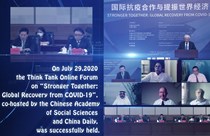Major innovations of Chinese modernization from historical views
Author : Yu Heping Source : Chinese Social Sciences Today 2023-02-28
The connotation of modernization denotes what modernization covers. What is modernization? Before the popularization and application of the modernization concept, countries around the world had undertaken certain reformative measures that could be considered “modernization” in hindsight. But they did so without consciously trying to modernize per se, nor were they aware of what modernization denotes in conceptual sense. Their only considerations were the wealth and strength of their countries. With the exception of Britain, which first embarked on the road to modernization, other countries were mere imitators of those nations whose wealth and strength preceded theirs.
Concept evolution in the West
The early modernization of European countries and the US, for example, was modeled after Britain, known as the “Anglicization.” The modernization of Japan in the early period followed the example of Europe and the US, also known as “Europeanization” or “Westernization.” The early modernization of China was initially similar to that of Japan, also known as “Westernization,” until 1921 with the introduction and application of Marxism and the concept of modernization.
Since the idea of modernization first appeared in the West, relevant modernization theory was also first generated and practiced there. However, since the fountainheads of modernization were composed primarily of Western experience, people’s understandings of the connotation of modernization are limited. Such modernization mainly included the capitalist industrialization and democratization, and urbanization and scientification derived from industrialization. Therefore, the theory of modernization at this time was essentially a theory which spread Western capitalist modernization, in an attempt to lure the follow-up countries and those countries which had not realized modernization into imitating the Western path. Although the content of Western modernization theory later changed, the change was not significant.
System of Chinese modernization
After the concepts of Marxism and Western modernization were introduced into China, they soon attracted the attention of Chinese academia and people with lofty ideals. The rate at which the word “modernization” appeared in newspapers and periodicals gradually grew. Especially under the influence of Marxism and the Soviet Union, the notion of socialist modernization began to emerge in China, in line with the revolutionary tenet of the Communist Party of China (CPC). From 1946 to 1949, the issues of Chinese industrialization and democratization were frequently mentioned. After the founding of the People’s Republic of China, China planned in 1958 about accomplishing modernization in sectors of industry, agriculture, national defense, and science and technology.
After the reform and opening up, Chinese modernization was proposed, and theoretical and practical explorations were carried out. Theoretical propositions and ways of practice were put forward. After the 18th CPC National Congress, the understanding of modernization has been continuously improved and extended. In the report to the 20th CPC National Congress, the theoretical system of Chinese modernization was put forward, and the connotation of Chinese modernization was explicitly stated: “It is the modernization of a huge population; It is the modernization of common prosperity for all; It is the modernization of material and cultural-ethical advancement; It is the modernization of harmony between humanity and nature; It is the modernization of peaceful development.”
Generality and uniqueness
Containing the generality of global modernization, Chinese modernization also highlights what is unique to China. The connotation of global modernization is amorphous and miscellaneous. Different theories have different references, such as industrialization, marketization, democratization, legalization, urbanization, scientization, and secularization. The connotation of Chinese modernization not only includes these connotations in their general sense, but also clearly points out the five-pronged connotations unique to China.
What is more prominent is that the connotation system of Chinese modernization reflects the ultimate people-oriented goal. The purpose of everything is to improve people’s living standard and living environment. This ultimate goal of modernization has never been articulated within the general connotation of global modernization. Capitalist modernization takes capital as the core, and its main purpose is to pursue the proliferation and accumulation of capital. Even if it can improve people’s living standards and living environment in the objective sense, it is just a way of passive profit distribution, and cannot be popularized to all the people.
Yu Heping is a research fellow from the Institute of Modern History at the Chinese Academy of Social Sciences.
Ye Shengtao made Chinese fairy tales from a wilderness
Ye Shengtao (1894–1988) created the first collection of fairy tales in the history of Chinese children’s literature...
-
How northern ethnicities integrated into Chinese nation
2023-09-18
-
Mogao caves
2023-09-12
-
Mogao Grottoes as ‘a place of pilgrimage’
2023-09-12
-
Time-honored architectural traditions in China
2023-08-29
-
Disentangling the civilizational evolution of China
2023-08-28
-
AI ethics in science fiction
2023-08-23














 2011-2013 by www.cssn.cn. All Rights Reserved
2011-2013 by www.cssn.cn. All Rights Reserved